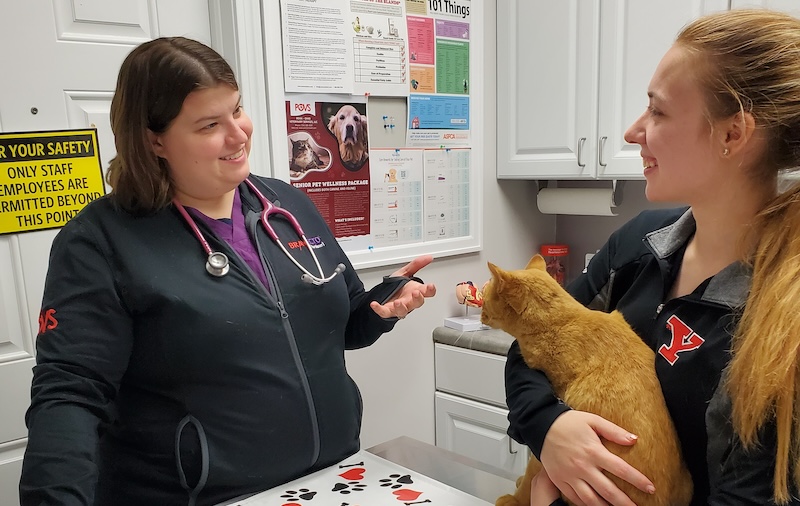I’m a “money hungry” veterinarian. Or at least that’s what I was told in one of my early practices. And that didn’t come from a client.
As an early career veterinarian, I recommended more diagnostic testing than my experienced colleagues did. It’s what I was taught to do to practice “good” medicine. But my team members thought I was doing it to increase invoices and make more money.
I wish I could say this experience was unique, but I hear similar stories over and over. Let’s look at the reasons this mismatch in perceptions happens and how we can solve this problem as mentors–and as teams that embrace a spectrum of care.
The New Grad Perspective
New graduate veterinarians often recommend more diagnostics than their experienced colleagues. There are two main reasons for this:
- Veterinary education focuses on traditional “gold standard” practice, which tends to be diagnostic-heavy. When you’ve spent four years hearing that this is how things are done, that’s the way you practice.
- Early career veterinarians have less clinical experience to rely on, which impacts their confidence. Diagnostic testing helps boost this confidence and provides comfort that they aren’t missing something.
As a new graduate, I believed that the testing I recommended was necessary for the best outcomes. I was also so afraid of missing something, that I would strongly recommend diagnostics for most of my patients. Sometimes the recommendation was just as much of a safety net for me as it was necessary for my patients. But I didn’t recommend diagnostics because I was looking at the price tag on them and trying to figure out how to make more money on a case.
The Team Perspective
Now consider the fact that veterinary team members are often tasked with reviewing financial estimates with clients. They see first-hand the client reaction to cost and may be asked questions to clarify why certain tests are being recommended.
If the team member reviewing the estimate is used to working with clinicians who recommend fewer (or more targeted) diagnostics, they may not understand why the newer doctor is recommending more tests. They also may begin to feel uncomfortable continually presenting higher estimates to clients, particularly if they have previous knowledge that a client is limited financially.
These experiences can lead to them questioning the way their new doctor practices. (By the way, this can happen even when experienced doctors join a practice if their style differs greatly from the existing team). If team members are not comfortable asking the doctor why they are recommending certain tests, they may incorrectly assume that the new doctor is recommending tests simply to increase their production. This is part of what happened in my own experience.
The Client Perspective
The diagnostic-heavy approach to cases can also impact the relationship between clients and new graduates who are working to build their client base. Some clients may run diagnostics because they feel they don’t have another choice, but are unhappy about feeling pressured. Others who truly can’t afford the cost of testing may leave feeling guilty for not doing the best they can for their pet. Clients with these experiences may request not to see the same doctor in the future and could even decide not to return to the practice at all.
For clients who are used to the way the established veterinarians practice, the difference in recommendations could be jarring. If a client is used to treating symptomatically for their dog’s acute vomiting, they may be confused when the new doctor strongly recommends radiographs and lab work. This may lead to distrust of either the new vet, who is doing things differently, or the previous vet, who didn’t push for testing they now believe is crucial.
My Evolution
With experience, I’ve become much more selective in my diagnostic recommendations. I’m more confident in my ability to assess a patient based on signalment, history, and physical examination. This doesn’t mean I don’t recommend diagnostic testing. In fact, I always discuss them, but the way I make recommendations has changed.
Now let me be clear, I don’t want any veterinarian to ever feel guilt for recommending diagnostic testing, because it is a crucial part of veterinary practice. And it is good medicine. But it doesn’t make not running diagnostics inherently bad.
Part of the art of veterinary practice is choosing which diagnostics to prioritize. This is particularly important for clients with financial constraints. Part of practicing a spectrum of care is judiciously choosing diagnostics.
So What Can We Do?
There is not one single solution to this problem. Early career veterinarians must become comfortable with the spectrum of care and learn to provide a range of options to each client, both diagnostically and therapeutically. This will take time.
Mentors can support this development by demonstrating this style of practice, discussing how they make their own decisions on when and how to recommend diagnostics, and teaching how to make strong but compassionate recommendations. When discussing cases, mentors can ask questions that encourage their mentees to critically evaluate their diagnostic plan:
- What information are you looking for with each test?
- How will that information change your treatment plan?
- Is there another way to get this information? (I.e. a smaller chemistry panel or running a PCV and looking at a blood smear instead of a CBC).
Team members have an important role too. If you’re a team member who is uncomfortable with the estimate you are asked to present or don’t understand why a test is being recommended, take the time to talk to your doctor. You won’t have time to discuss every case in the moment, but it is okay to ask a quick clarifying question. It’s also okay to ask follow-up questions later, as long as you come from a place of curiosity and not judgment.
Don’t want to miss more content like this? Join the MAILING LIST today!
THREE-STEP ACTION PLANS:
Action Steps for Mentees
- Critically evaluate the diagnostics you are offering.
- Clearly communicate your recommendations to clients and team members.
- Discuss your diagnostic choices with your mentor or other doctors.
Action Steps for Mentors
- Ask your mentees questions that encourage them to think about a range of options when approaching a case.
- Discuss how you approach similar cases.
- Highlight how to best communicate diagnostic recommendations.
Action Steps for Teams
- Discuss cases as a team to learn why certain testing is recommended by the doctors.
- Create a safe, nonjudgmental space to ask questions of individual doctors about particular cases.
- Don’t make assumptions about a doctor’s motivations behind diagnostic testing. Ask them.
Further Reading
Can’t wait to read more about spectrum of care from Dr. Boatright?
Check out the recommended articles below or see the PUBLICATIONS page for a full list of articles.

